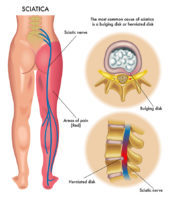How to Sleep with Anterior Pelvic Tilt?
Anterior Pelvic Tilt (APT) is a common postural issue that can lead to discomfort and pain, especially during sleep. This condition occurs when the front of the pelvis tilts forward, causing an exaggerated curvature of the lower back. While addressing APT during waking hours often involves exercises and lifestyle adjustments, it’s equally important to consider how you sleep, as poor sleeping positions can exacerbate the problem.
In this article, we will explore various sleeping positions, pillows, and tips to help individuals with Anterior Pelvic Tilt find comfort and achieve a restful night’s sleep. By making simple adjustments to your sleep routine, you can reduce discomfort, alleviate pain, and wake up feeling refreshed and rejuvenated.
Table of Contents
What Is Anterior Pelvic Tilt?
The lower back is arched and the hips are tilted forward in an anterior pelvic tilt.
Lower back, hips, and leg discomfort and pain may occur from this. It is brought on by weak glutes, tight hip flexors, and weak abdominal muscles.
When your pelvis is towards the floor from the front, this is referred to as an anterior tilt. It’s not a severe orthopedic disorder. Simply put, it indicates that particular muscles are positioned in your pelvis in a less-than-optimum manner at the front.
Your lower back will develop an arch in this position, which is not optimal from a biomechanical standpoint. The term “hyperlordosis” refers to this prominent bend in your lower back.
Hyperlordosis is not a serious illness or condition. It simply indicates that your lower spine is curvier than what is healthy for your hip muscles and bones.
Different Pelvic Tilts
Anterior, posterior, and lateral pelvic tilts are the three different forms of pelvic tilt.
- When the lower back is arched and the hips are tipped forward, this is known as an anterior pelvic tilt.
- When the lower back is flattened and the hips are tipped backward, posterior pelvic tilt occurs.
- When the spine is curved and the hips are inclined to one side, lateral pelvic tilt results.
Why does the anterior pelvic tilt occur?
An anterior pelvic tilt is caused by weak glutes, tight hip flexors, and weak abdominal muscles.
To lessen the stiffness and pain brought on by anterior pelvic tilt, it is crucial to stretch and strengthen these muscle groups. Muscles that support the lower back and hips can be strengthened with exercises like bridges, planks, and bird dogs.
Stretching and foam rolling can also help reduce tightness and discomfort. If the issue continues, seek further advice from a medical expert.
Health Problems Associated with Anterior Pelvic Tilt A number of health problems, including but not limited to:
- Lower back soreness and pain
- Back pain
- A sore groin
- Sciatica pain and lower back stiffness
- Forced rotations of the knee and hip
- Man holding back owing to back pain, which might result in poor posture and increased pain and anguish
What is the ideal pelvic alignment?
The hips should form a 90-degree angle with the spine in the neutral pelvic position, which is the ideal pelvic alignment.
Your spine and pelvis are in the best posture in this position to lessen discomfort and pain.
Neutral pelvic posture:
The position in which your hips point and pubic bone form a triangle perpendicular to the floor is referred to as a neutral pelvis. The lumber spine (lower back) structures will be under the least amount of stress thanks to this alignment. In order to avoid compression in your lower back and movement issues in your hip joints, you can control your pelvis and spine in this position.
But everyone’s pelvic bones are unique in shape. In fact, if you compare the two sides of your own pelvis, it is almost certain to be asymmetrical. Because of this, it is challenging to provide precise measures that are suitable for everyone.
In order to keep your pelvis in a more neutral posture if it is already tilted anteriorly, Abs, hamstrings, and glutes should be worked without feeling like you are expending all of your physical and mental energy.
Test for Anterior Pelvic Tilt by Thomas:
An easy test to measure anterior pelvic tilt is the Thomas Test.
How to run the test:
- Lay down on your back with your legs hanging over the side.
- One knee should be brought up to the chest and held there with your hands.
- It shows an anterior pelvic tilt if the opposing leg stays flat on the ground.
- The Thomas Test can be used to detect anterior pelvic tilt, but a doctor should be contacted for a conclusive determination.
How does anterior pelvic tilt change during sleep?
It all comes down to muscle length and engagement for pelvic tilt. Whatever you train your muscles to do, they will do. Your muscles become proficient at working at an anterior tilt if you tilt your pelvis frequently. Your muscles then work valiantly to free you from that anterior tilt.
Your muscles will spend the entire night maintaining an anterior tilt if you sleep with your pelvis tilted anteriorly. Why subject yourself to it when you can correct your anterior tilt as you sleep with a few easy adjustments?
Eight hours of sleep equates to eight hours of anterior pelvic tilt exercise. Learning how to sleep with your spine and pelvis in the position you choose is crucial for this reason.
Although it won’t completely solve all of your anterior pelvic tilt issues, if you can keep your pelvis in a neutral position overnight, it will assist your muscles in learning to keep it that way throughout the day.
Your anterior pelvic tilt may be impacted by how you sleep.
Your hips may be pulled into an anterior pelvic tilt if you sleep on your stomach. Your hips may be pulled into a posterior pelvic tilt if you sleep on your back.
As a result, your pelvic tilt is significantly impacted by the way you sleep. Your spine will progressively revert to a proper posture the more you sleep in a position that corrects anterior pelvic tilt, and vice versa.
How to sleep with anterior pelvic tilt?
Maintaining a neutral pelvic position is crucial when sleeping with an anterior pelvic tilt. You can achieve this by supporting your lower back with a pillow and maintaining hip alignment by placing a body pillow between your legs.
Your sleeping posture has a significant impact on how you feel when you wake up the following morning. The extent to which your sleeping posture affects your physical health is frequently underestimated. Lower back discomfort might be brought on by an uncomfortable sleeping posture that aggravates the muscles.
However, a person’s preferred sleeping position is frequently influenced by their own set of back issues. Here are some recommendations for sleeping positions that will help to reduce the pain brought on by anterior pelvic tilt and lower back pain.
There are three main sleeping postures and techniques you should use for this:
Side sleepers:
The preferred position for those with anterior pelvic tilt is to sleep on their side, although this is not the best position. The spine can bend to the side and rotate in this position, which could result in lower back pain. Place a pillow, preferably a knee pillow, between the knees to ease the strain on the lower spine and make this sleeping posture more comfortable. You can also tuck a towel or sheet folded lengthwise under your waist.
It could be preferable to get some shut-eye in a reclining chair or an adjustable bed if your lower back pain seems to be there regardless of how you lie down. If you sleep with your head and knees elevated, the pressure on your nerves will be eased.
For side sleepers, we advise placing a supporting pillow between your legs while you are asleep to keep your hips and spine in proper alignment.
Position of the spine for side sleepers:
- When side sleeping without a pillow between your knees, make sure the pillow between your body reduces the stress on your lower back caused by one leg tilting sideways.
- Once you’ve done so, bend your body into a semi-tucked position with a tiny curvature in your back to relieve pressure on your spine in a more posterior position.
- Additionally, it’s crucial to choose a mattress that fits your body shape so that your hips and shoulders can sag into it just enough to prevent the development of lateral pelvic tilt.
Back sleepers:
The ideal slumber position
Even if sleeping on your side may be more comfy for your mind. The ideal sleeping posture, according to experts, is on your back. The natural bend of the lower back that results from sleeping on your back lessens overall spinal tension.
Even though in general this is the best sleeping position, some people may not find it to be their preferred option. Those with spinal stenosis, hip discomfort, or back osteoarthritis may notice an aggravation of their symptoms when they awaken. Place a Leg Elevator/Pillow or other raised object (such as a towel or blanket that has been rolled up) under the back of your knees to prevent this. This will make the position more comfortable and remove stress from the back.
Our preferred and top-recommended strategy for treating anterior pelvic tilt is back sleeping.
Here’s what we advise you to do:
Position of the spine for back sleepers
- Sleep comfortably on your back.
- Your knees will rise as a result of pulling your legs closer to your torso.
- Suspend a pillow beneath your knees.
- Legs stretched out over pillow
- Your back should now curve posteriorly as a result of raising your knees. Your lower back will feel so much better and less stressed as a result.
- Your spine will eventually realign and regain its natural position if you sleep in this position.
Stomach sleepers:
Do Not Tilt Your Pelvic Front While Lying on Your Stomach
Using a pillow and a stomach-down position
After a filling dinner at an all-you-can-eat buffet, it may seem ideal to take a pleasant nap on your stomach. However, doing so can cause neck and back pain. The lower back is immediately and unnecessarily burdened by this sleeping position since it curves the cervix and the thorax.
However, sleeping on your stomach could help lessen some disc strain if your back pain is due to degenerative disc disease. Simply position a flat pillow beneath the stomach and hips if this is the situation. This will help relieve any stress on your lower back.
Overall, if you have anterior pelvic tilt, we do not advise frequently sleeping on your stomach. Stomach sleeping can significantly increase your anterior pelvic tilt by creating a large anterior curve.
But if you have to, follow these instructions.
- Position of the spine for stomach sleepers
- To ensure that your back curls inward when you are lying on your stomach while sleeping, tuck a supportive pillow beneath your stomach (perhaps between your stomach and pelvis).
- Your body should be compelled to assume a more posterior position as a result. lowering the anterior tilt as a result.
Having said that, we still strongly advise that you avoid sleeping on your stomach as much as possible and instead use the preceding 2 techniques for side sleeping and back sleeping postures.
Most crucially:
Use a mattress that is firm enough to support your spine; this is crucial. Choosing a mattress that is overly plush will cause your spine to curve too much.
You must therefore spend money on a quality mattress.
Hybrid Layla Mattress
The Layla Hybrid Mattress, which we evaluated extensively, is the greatest mattress we could find for addressing anterior pelvic tilt and spinal alignment.
Consider investing in a quality mattress; it will change your life.
A bed base that is adjustable would be a fantastic addition. Your legs can be raised higher to correct an anterior pelvic tilt by curling up the base of an adjustable bed.
Avoiding Anterior Pelvic Tilt while sleeping
Avoid placing yourself in a situation where your anterior tilt will be noticeable. You are encouraging an anterior tilt, for instance, if you sleep on your stomach and your stomach sinks into the bed, tipping your low back into lordosis. Get your body accustomed to staying in neutral pelvic postures by finding them.
In other words, lying on your stomach will emphasize your anterior tilt, especially if you’re on a soft bed.
Avoid sleeping on your stomach or in any other posture that causes your hips to tilt forward, particularly if you don’t have a pillow under your stomach to raise your pelvis.
A mattress that is overly soft should also be avoided because it can leave your spine unsupported as you sleep on it.
Instead, adhere to the suggestions made for the various sleeping positions in the preceding section.
Summary:
Your ultimate goal shouldn’t be to stay in a fixed position the entire night. By sleeping in these anterior tilt postures, you can train your body to locate neutral more quickly. While you are sleeping, these positions won’t entirely correct your anterior tilt.
You must gradually hone your muscles to keep your pelvis neutral in order to correct anterior tilt. Stretching, strengthening, and learning how to consciously manage your pelvis position may all be necessary for this.
To assist you in enhancing your anterior tilt inclinations throughout the day (and all night), you should also combine exercises for an anterior pelvic tilt with adjustments like these.
FAQs
Does the way you sleep affect your anterior pelvic tilt?
You are encouraging an anterior tilt, for instance, if you sleep on your stomach and your stomach sinks into the bed, tipping your low back into lordosis. Finding them can help you to train your body to maintain neutral pelvic positions. In other words, sleeping on your stomach, especially on a soft bed, will accentuate your anterior tilt.
With pelvic pain, what sleeping posture is best?
In general, side sleeping is advised because it relieves pressure on your spine and lower body. For added comfort and lumbar support, try sleeping with a cushion between your knees. If at all possible, avoid lying flat on your back since this might cause discomfort and increased pressure in the lower abdomen.
Why does anterior pelvic tilt get worse?
Anterior pelvic tilt is also influenced by weak stomach muscles. Spending a lot of time sitting down can alter the curvature of the spine and lead to muscular imbalances. Anterior pelvic tilt can also be brought on by a lack of stretching or strengthening activities.
Can sciatica result from an anterior pelvic tilt?
Pelvic tilt is a largely disregarded factor, nevertheless, in sciatica. The majority of people are prone to anterior pelvic tilt, in which the front of the pelvis elevates and tilts forward. Thankfully, this can be fixed with exercises as a long-term Sciatica treatment.







